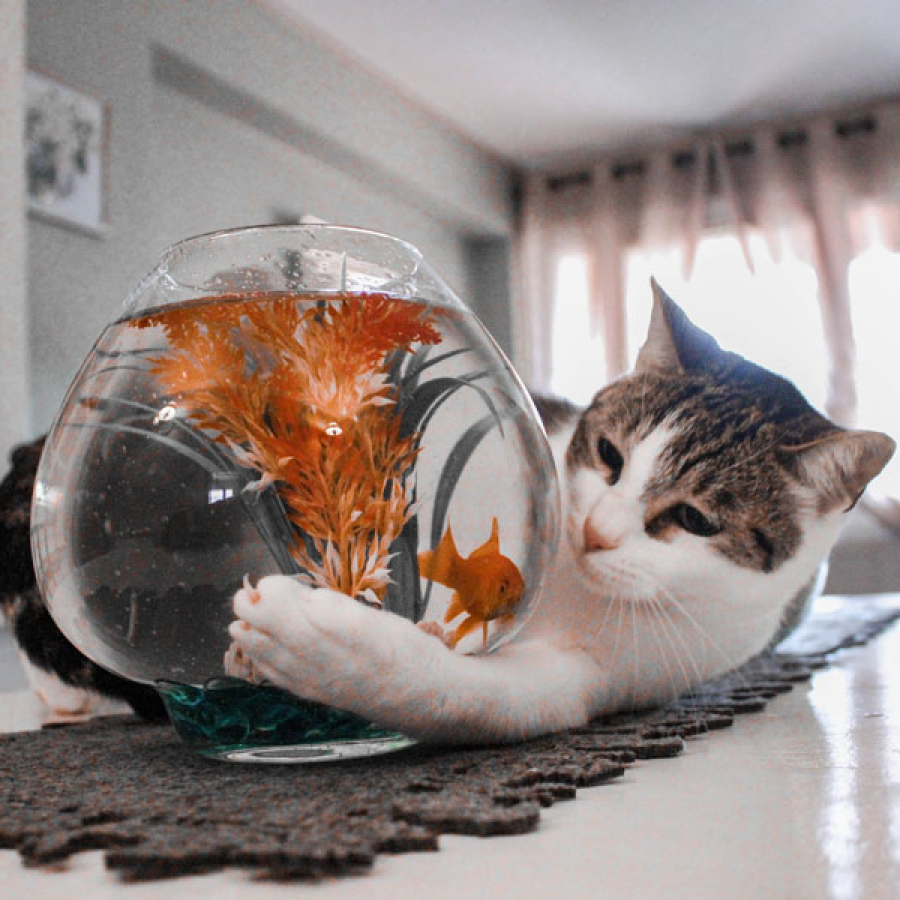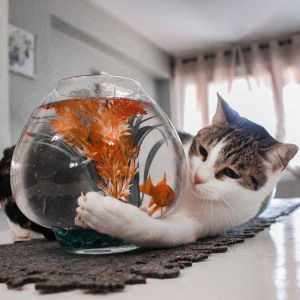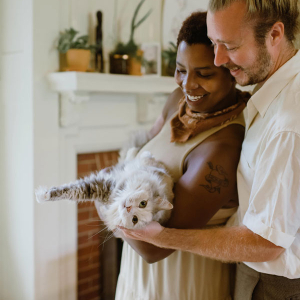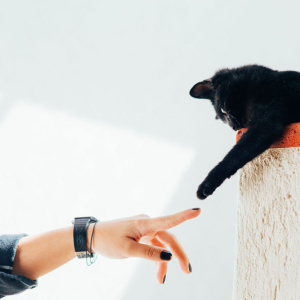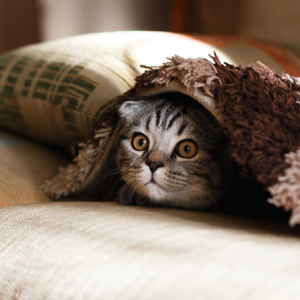Crouch down low, watch, and when it’s just the right moment … wobble your back paws and pounce! Whether your kitty is pouncing live prey outside or their mouse toy inside, cats are playful despite their reputation for sleeping 12 to 18 hours per day. Many cats’ playful characteristics begin when they are kittens practicing being successful predators. In fact, cat behavior runs deeper than the cute cat videos you watch on social media. The tail twitching, pouncing/jumping, face rubbing, kneading (making biscuits), purring and many more behaviors are a cat’s way of communicating and preserving their instinct.
What’s that sound? How a cat purrs still has some unanswered questions, but why a cat purrs can warm the owner’s heart. The purr officially comes from the “purr center” located in the base of the brain. Once emotions stimulate the “purr center,” vibrations are sent to the opening of the windpipe by the vocal cords. As kitty inhales and exhales, air moves across the vocal cords producing the purr. (Fun fact: like our domestic cats, cheetahs, pumas, ocelots, servals, and lynxes all purr. Lions, tigers, leopards, and jaguars cannot purr.) A kitten’s purr is used to let the momma cat know the baby is present. As the kitten becomes a cat, the purr communicates emotion and satisfaction. After a meal or play, kitty may come to you purring ready for some cuddle time. Usually, the purr is shared with a favorite person or animal. Purrs vary from a low rumble to a loud melody. Some purrs, help calm kitty like some nervous habits calm some people. Either way, the purr is an important part of communication, so pay close attention!
What’s that smell? Ever notice your kitty rubbing his/her face on you or various objects? Is this an emotional characteristic like the purr or territorial? Cats have scent-producing glands on their head and face. Fortunately for us, we don’t smell the scent, but other kitties do! The scents are full of information like is the first kitty male or female, in heat or not, or how long ago the kitty visited the spot and if it will return. If you live in a multi-cat household, or take care of a cat community, the scent helps develop a community scent to determine who belongs or not. When Kitty rubs on their people, they are including the people’s scent as part of the community scent. The face rub is the secret handshake of the domestic cat community; feel honored to be included!
Making biscuits! Well, I’m not too sure Kitty should attempt to bake homemade biscuits, but they sure know how to knead like they are prepping the dough! Instinctually, kittens knead when nursing. Most cats continue to knead in adulthood as comfort. Studies show that whether cats weaned too early or not, it will not determine if they will knead as adults. While cats are being pet, they will show contentment and love by kneading. Kneading is also a great way to make a bed when ready for a nap. Scent glands are found in kitty paws, allowing kneading to leave behind the kitty scent. When you are the recipient of kneading, know you have a special place in your kitty’s heart.
Wait for it … Pounce! After a nice nap, dusk and dawn are a favorite time for kitty to get the zoomies! Zoomies are when kitty’s predatory instinct drives them to run, jump and pounce like it’s time to hunt. As kittens, they get a lot of practice and learn different ways to effectively hunt. As they get older, playtime slows some but the drive to hunt continues. Our indoor kitties enjoy play time with their kitty siblings or their people. Toys with feathers, wands with stuffed fish or mice, catnip-filled toys, or a noisy ball will give Kitty great playtime. Our outdoor kitties tend to find lizards, bugs and other small prey but will also enjoy inside play. A kitty’s drive to hunt is different than their drive to eat. While they are engaged with prey, if they see another object or creature that gets their interest, they will move to the next prey. To avoid boredom, always try new toys and play with your kitty. They will appreciate the time you spend satisfying their hunting instinct.
Read that body language … Kitty is telling you something! Ever notice when you spend lap time/cuddle time with your kitty, the tail sometimes twitches or after plenty of pets you get a little nip/bite? As much as our babies love their people’s pets and cuddles, even they get tired and want to be left alone. The tail is very important in determining your kitty’s mood. The tail twitches when Kitty is hunting, but if Kitty is not hunting, a twitchy tail represents frustration. If you notice a thrashing tail while petting Kitty, be forewarned! A thrashing tail expresses irritation or anger. If you don’t stop, you may get a nip or a bite! Kitty says, ‘That’s enough! I need my personal space now!’ Usually, the nip/bite does not harm unless you push Kitty’s patience too far. Any cat bite should be watched closely and treated quickly. Best bet is to watch Kitty’s mood closely if biting is one of their means of communication. When you get home, does your kitty wrap their tail around your leg? Just like humans, kittens like to greet with a handshake, hug or high-five. They rub your legs and wrap their tails around you, letting you know they are happy to see you and want to interact. Kitty tail reading is one of the best reads as a cat owner.
What’s in the box? In the era of online ordering, we get a lot of boxes. As you unpack your latest package, Kitty is right there ready to hop in the box. Why do they do this? “Kitty, didn’t I just buy you the fancy new kitty condo with places to sleep?” As you know, kitties are ambush predators. Therefore, hiding in a box is a great way to watch and sneak up on prey. Boxes help reduce stress and give Kitty a safe space to nap. The one-way-in, one-way-out characteristic of a box gives Kitty full view of an approaching threat. Studies show that a box is a great way to help Kitty adjust to new surroundings. A cardboard box also has great insulation, making a warm place for a nap for indoor and outdoor kitties. Who knew the cardboard box had so many uses!
Who’s singing … in the middle of the night? Naturally, kitties are more active at night, but late-night meows can represent different things. Of course, among younger kitties their hunting instinct leads to late-night activity which include meows. Fortunately, as the kitten matures, kitty adjusts to their human’s schedule and reduce the late-night meows. Some cats meow late at night due to boredom. Setting aside some evening playtime can help reduce the boredom and meows. Unfortunately, late-night meows can be a sign of aging or some health issues. If so, be sure to meet with your vet! Finally, late night meows can be a mating call. The best resolution is spay/neuter and control the cat population.
Communication is key to a happy cat home! Each kitty has a different personality and learning the cues will help you give the best care. Learn if your kitty prefers cuddle time on the sofa, bedtime cuddles and what toys keep them entertained, and life will be a complete joy with your feline.
What’s that sound? How a cat purrs still has some unanswered questions, but why a cat purrs can warm the owner’s heart. The purr officially comes from the “purr center” located in the base of the brain. Once emotions stimulate the “purr center,” vibrations are sent to the opening of the windpipe by the vocal cords. As kitty inhales and exhales, air moves across the vocal cords producing the purr. (Fun fact: like our domestic cats, cheetahs, pumas, ocelots, servals, and lynxes all purr. Lions, tigers, leopards, and jaguars cannot purr.) A kitten’s purr is used to let the momma cat know the baby is present. As the kitten becomes a cat, the purr communicates emotion and satisfaction. After a meal or play, kitty may come to you purring ready for some cuddle time. Usually, the purr is shared with a favorite person or animal. Purrs vary from a low rumble to a loud melody. Some purrs, help calm kitty like some nervous habits calm some people. Either way, the purr is an important part of communication, so pay close attention!
What’s that smell? Ever notice your kitty rubbing his/her face on you or various objects? Is this an emotional characteristic like the purr or territorial? Cats have scent-producing glands on their head and face. Fortunately for us, we don’t smell the scent, but other kitties do! The scents are full of information like is the first kitty male or female, in heat or not, or how long ago the kitty visited the spot and if it will return. If you live in a multi-cat household, or take care of a cat community, the scent helps develop a community scent to determine who belongs or not. When Kitty rubs on their people, they are including the people’s scent as part of the community scent. The face rub is the secret handshake of the domestic cat community; feel honored to be included!
Making biscuits! Well, I’m not too sure Kitty should attempt to bake homemade biscuits, but they sure know how to knead like they are prepping the dough! Instinctually, kittens knead when nursing. Most cats continue to knead in adulthood as comfort. Studies show that whether cats weaned too early or not, it will not determine if they will knead as adults. While cats are being pet, they will show contentment and love by kneading. Kneading is also a great way to make a bed when ready for a nap. Scent glands are found in kitty paws, allowing kneading to leave behind the kitty scent. When you are the recipient of kneading, know you have a special place in your kitty’s heart.
Wait for it … Pounce! After a nice nap, dusk and dawn are a favorite time for kitty to get the zoomies! Zoomies are when kitty’s predatory instinct drives them to run, jump and pounce like it’s time to hunt. As kittens, they get a lot of practice and learn different ways to effectively hunt. As they get older, playtime slows some but the drive to hunt continues. Our indoor kitties enjoy play time with their kitty siblings or their people. Toys with feathers, wands with stuffed fish or mice, catnip-filled toys, or a noisy ball will give Kitty great playtime. Our outdoor kitties tend to find lizards, bugs and other small prey but will also enjoy inside play. A kitty’s drive to hunt is different than their drive to eat. While they are engaged with prey, if they see another object or creature that gets their interest, they will move to the next prey. To avoid boredom, always try new toys and play with your kitty. They will appreciate the time you spend satisfying their hunting instinct.
Read that body language … Kitty is telling you something! Ever notice when you spend lap time/cuddle time with your kitty, the tail sometimes twitches or after plenty of pets you get a little nip/bite? As much as our babies love their people’s pets and cuddles, even they get tired and want to be left alone. The tail is very important in determining your kitty’s mood. The tail twitches when Kitty is hunting, but if Kitty is not hunting, a twitchy tail represents frustration. If you notice a thrashing tail while petting Kitty, be forewarned! A thrashing tail expresses irritation or anger. If you don’t stop, you may get a nip or a bite! Kitty says, ‘That’s enough! I need my personal space now!’ Usually, the nip/bite does not harm unless you push Kitty’s patience too far. Any cat bite should be watched closely and treated quickly. Best bet is to watch Kitty’s mood closely if biting is one of their means of communication. When you get home, does your kitty wrap their tail around your leg? Just like humans, kittens like to greet with a handshake, hug or high-five. They rub your legs and wrap their tails around you, letting you know they are happy to see you and want to interact. Kitty tail reading is one of the best reads as a cat owner.
What’s in the box? In the era of online ordering, we get a lot of boxes. As you unpack your latest package, Kitty is right there ready to hop in the box. Why do they do this? “Kitty, didn’t I just buy you the fancy new kitty condo with places to sleep?” As you know, kitties are ambush predators. Therefore, hiding in a box is a great way to watch and sneak up on prey. Boxes help reduce stress and give Kitty a safe space to nap. The one-way-in, one-way-out characteristic of a box gives Kitty full view of an approaching threat. Studies show that a box is a great way to help Kitty adjust to new surroundings. A cardboard box also has great insulation, making a warm place for a nap for indoor and outdoor kitties. Who knew the cardboard box had so many uses!
Who’s singing … in the middle of the night? Naturally, kitties are more active at night, but late-night meows can represent different things. Of course, among younger kitties their hunting instinct leads to late-night activity which include meows. Fortunately, as the kitten matures, kitty adjusts to their human’s schedule and reduce the late-night meows. Some cats meow late at night due to boredom. Setting aside some evening playtime can help reduce the boredom and meows. Unfortunately, late-night meows can be a sign of aging or some health issues. If so, be sure to meet with your vet! Finally, late night meows can be a mating call. The best resolution is spay/neuter and control the cat population.
Communication is key to a happy cat home! Each kitty has a different personality and learning the cues will help you give the best care. Learn if your kitty prefers cuddle time on the sofa, bedtime cuddles and what toys keep them entertained, and life will be a complete joy with your feline.
Tagged in Kitty Korner in our Winter 2023 issue
